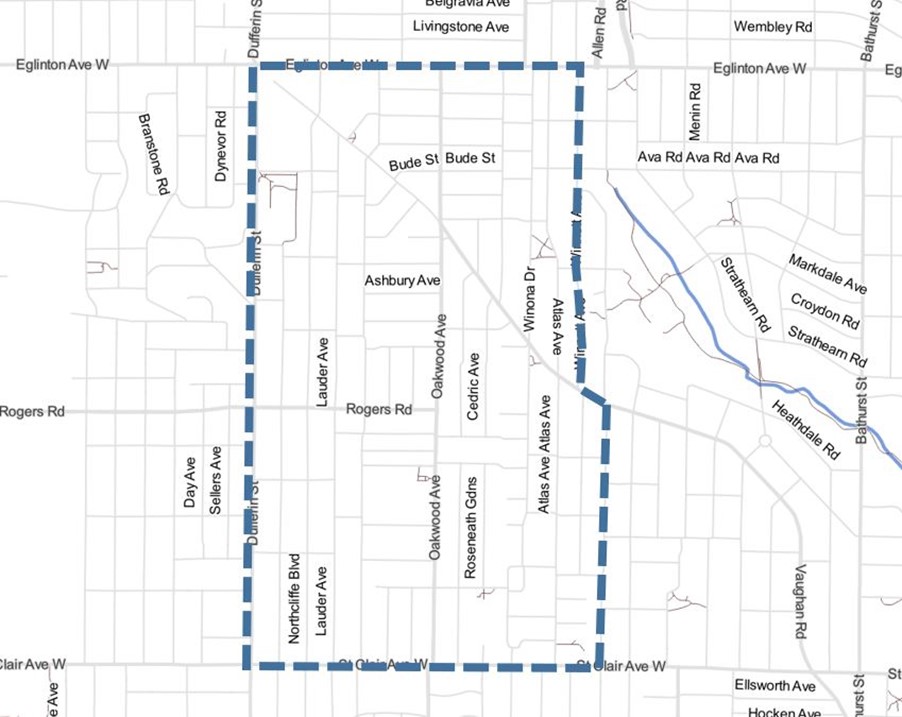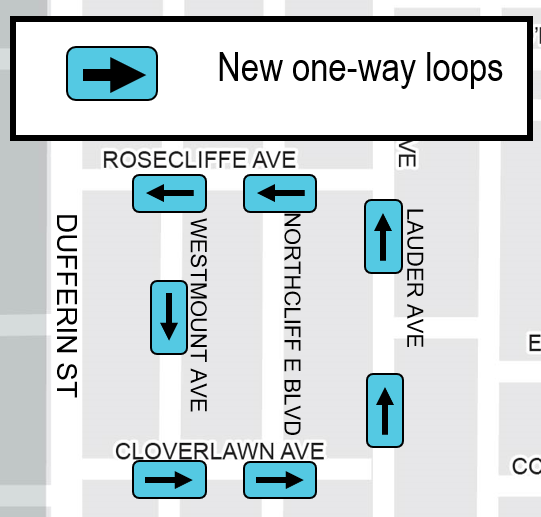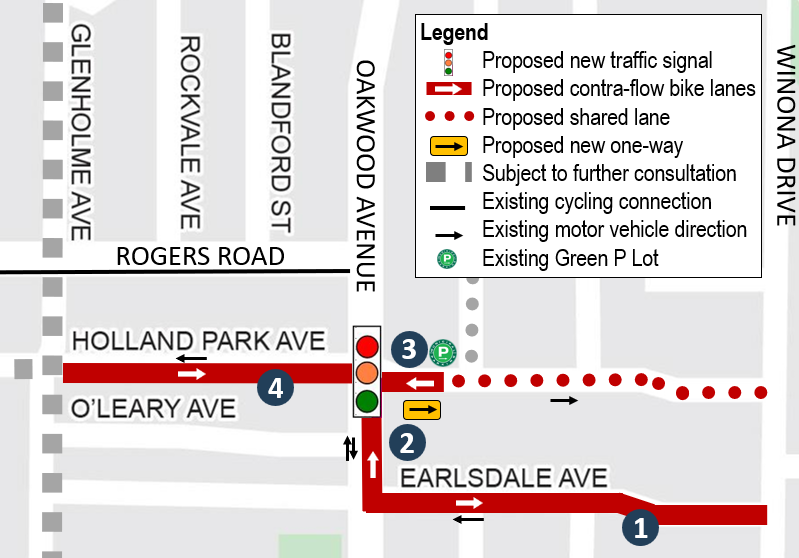
In consultation with the community, the City is developing a Neighbourhood Streets Plan for the Oakwood Village area. The plan will address concerns and opportunities identified through public feedback and data collection:
The City is seeking feedback on proposed changes and actions for each area of concern.
The project area is located between Dufferin Street to the west, St. Clair Avenue West to the south, Eglinton Avenue West to the north, and to the east from Arlington Avenue at St. Clair Avenue West to Vaughan Road to Winnett Avenue at Eglinton Avenue.

While we aim to provide fully accessible content, there is no translation or text alternative available for some of the content on this page. If you require translation, alternative formats or need assistance understanding our maps, drawings or any other content, please contact us at 416-392-2896 or email OakwoodVillageStreets@toronto.ca.
Neighbourhood Streets Plans (NSPs) are a new service for neighbourhoods where traffic and travel patterns challenge the safety and mobility of people using the streets. Through the NSP process, a team of City staff will work with communities to identify local issues and opportunities, prioritize the greatest needs, and recommend changes to traffic operations and street designs.
NSPs consider the needs of all road users and emphasize the safety of vulnerable road users such as seniors, school children, and people walking and cycling.
The Oakwood Village NSP will result in short-term actions (one to two years) which can be made using temporary, flexible materials like signs, paint, and bollards. The NSP will also identify longer term changes which can be accomplished alongside future programmed road work.
The outcomes of each NSP will be different based on local conditions and the needs of each neighbourhood. Generally, NSPs will recommend actions related to motor vehicle speed and volume management, and traffic safety conflicts on local streets.NSP recommendations are informed by the City’s Traffic Calming Guide, Vision Zero Action Plan, and Complete Streets Guidelines. Some examples of actions that may be considered include:
Streets Plans follow several steps outlined below, and public consultation takes place in two stages.
Streets Plans result in short-term actions which can be made using temporary, flexible materials like signs, asphalt, paint, and bollards, and identify longer term changes which can be accomplished alongside future programmed road work.
The outcomes of each Streets Plan are different based on local conditions and the needs of each neighbourhood. Generally, plans recommend actions related to motor vehicle speed and volume management, and traffic safety conflicts on local streets. Recommendations are informed by the City’s Traffic Calming Guide, Vision Zero Action Plan, and Complete Streets Guidelines.
The City of Toronto is inviting local residents, businesses and organizations to learn more and provide feedback. Consultation will take place over two stages between spring 2024 and fall 2025:
Public and interest group input, along with technical and policy considerations, are used to inform City staff recommendations and decisions to be made by City Council.
Public consultation for Phase 2 took place in fall 2025.
Public consultation for Phase 1 took place in spring 2024.
Residents have raised concerns about pedestrian safety on Oakwood Avenue. Changes to address road safety include new and upgraded pedestrian crossings, corridor safety improvements on Oakwood Avenue and intersection improvements such as curb extensions (bump-outs) to help reduce conflicts between road users.
Additional proposed changes to address road safety that will be considered by the Toronto and East York Community Council include:
See maps on page 24 of the information panels, and page 43 for near-term changes.
More details about Pedestrian Safety on Oakwood Avenue is shown on pages 22 to 24 of the information panels.
Residents have raised concerns about safety along Vaughan Road. The City has previously approved and made some improvements, including a Community Safety Zone from the west terminus to Arlington Avenue, which allows automated speed enforcement.
The following options to improve safety and mobility on Vaughan Road are proposed as part of the Streets Plan, including:
Some of the changes proposed for Vaughan Road are subject to further public consultation and detailed design development, as part of a separate project later in the fall of 2025*. A notice will be mailed once the date is confirmed.
Changes are proposed at the intersection of Vaughan Road and Oakwood Avenue to improve safety and mobility. The proposed changes include:
*Additional improvements to be considered as part of the design for the intersection include curb radii changes, changes to pedestrian crosswalk placement, accessible design, and placemaking at the southeast corner.
A new pedestrian crossing is proposed between Oakwood Avenue and Alameda Avenue. The two options for the location of the new proposed pedestrian crossing on Vaughan Road are:
Other improvements to be considered as part of the design for the corridor include lane width changes to manage speed, and options to upgrade the cycling connections.
See map on page 42 of the information panels.
More details about Vaughan Road safety identified by the Streets Plan are shown on pages 25 and 26 of the information panels.
Residents have raised concerns about traffic infiltration in the neighbourhood. The City has previously made some improvements, including reinstating restrictions on Eglinton Avenue West that were removed during the construction of the TTC Line 5 Eglinton.
Proposed changes to address traffic infiltration include: speed humps or speed cushions; extension of existing time-based restrictions; and changes to street direction to discourage non-local traffic.
Speed humps and speed cushions proposed on the following streets to address traffic infiltration will be considered by Toronto East York Community Council:
Extension of existing time-based restrictions are proposed on the following streets to address traffic infiltration will be considered by Toronto East York Community Council:
Changes to street direction proposed on the following streets to address traffic infiltration will be considered by Toronto East York Community Council:
Set of changes to create one-way loops

See maps on page 29 of the information panels, and page 43 for near-term changes.
More details about Infiltration on neighbourhood streets are shown on pages 27 to 29 of the information panels.
The plan proposes to focus safety improvements where there are higher levels of pedestrian activity and vulnerable groups such as children. Specific focus was placed around schools, shops and other locations identified for a higher risk to pedestrian safety or where there was a near-term opportunity due to upcoming road work projects.
Some of the proposed measures that address school and businesses needs include:
See maps on page 32 of the information panels, and page 43 for near-term changes.
More details about Infiltration on neighbourhood streets are shown on pages 30 to 31 of the information panels.
The plan proposes to build missing sidewalks over the long-term, improve pedestrian crossings and access to transit, and complete the cycling network to make it feel safer and easier to walk, bike, and take transit.
Some of the measures that address travel options without a car include:
See maps on page 32 of the information panels, and page 43 for near-term changes.
More details about Travel options without a car are shown on pages 33 to 34 of the information panels.
Residents have raised concerns about pedestrian safety on Oakwood Avenue, particularly crossing Oakwood Avenue at Holland Park Avenue and east-west cycling connections in the neighbourhood. The Plan proposes installing:

The new traffic signal at Holland Park Avenue would have an impact to on-street parking and would require the removal of 11 spaces.
The installation of the new traffic signal and east-west cycling connections will be considered by the Infrastructure and Environment Committee.
See map on page 36 of the information panels, and proposed cross-sections on pages 38 to 41.
Refer to the cycling roll plan for details.
More details about the need for East-West Connections and New Signal are shown on pages 35 to 41 of the information panels.
Please register to be added to the project list to receive updates by email, including information about public events or online surveys.